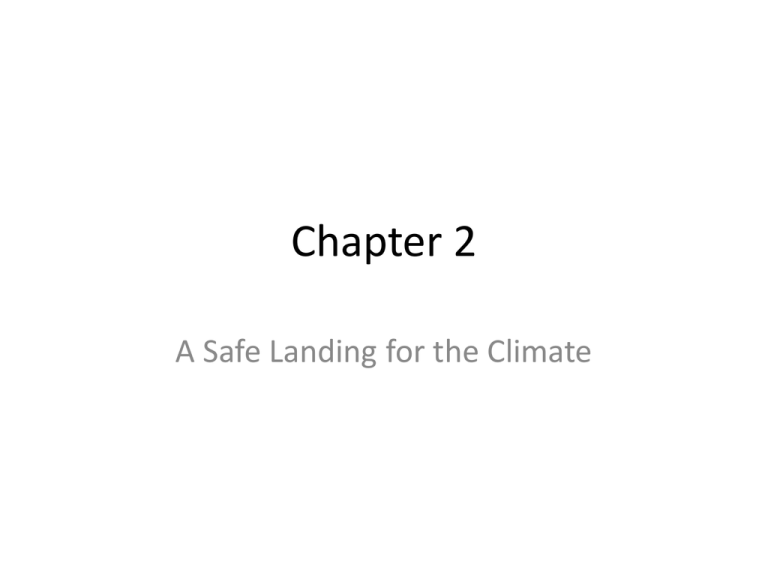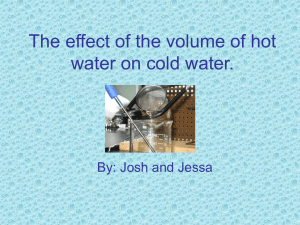Chapter 2 A Safe Landing for the Climate
advertisement

Chapter 2 A Safe Landing for the Climate A Safe Landing for the Climate • The climate has risen 0.7 degrees Celsius. • Most of this has occurred in the mid 20th century. • Human activities are most likely to be blamed. • Most recently, the Arctic has lost much of their ice. • The emissions of greenhouse gases are increasing by the increase in the burning of fossil fuels. • It’s expected to raise the Earth’s temperature by another 4-6 degrees Celsius by the end of this century. • If this does happen it will cause a lot of problems. • In 1992, the United Nations Framework Convention on Climate Change that was adopted in Rio de Janeiro at the Earth Summit. • “The main objective of this Convention is to stabilize the greenhouse gas concentrations in the atmosphere at a level that would prevent dangerous anthropogenic interference with the climate system. Such a level could be achieved within a time frame sufficient to allow ecosystems to adapt naturally to climate change, to ensure economic development to proceed in a sustainable manner.” • In 2007, the Intergovernmental Panel on Climate Change (IPCC) predicted that there would be serious risks and damages to species, ecosystems, human infrastructure, and societies in the future unless the warming is reduced. By reducing the greenhouse gas emissions it lowers the temperature. To determine whether it is dangerous or not to the environment affects the rate, timing, and scale of emission reductions required regionally and globally. If the global average temperature exceeds 4 degrees Celsius above the preindustrial level then there will be an urgent emphasis on global emissions reductions of 80% or more by 2050. • Water availability and weather extremes have a big impact on humans and the natural system. • Precipitation can be expected to decrease also. • In many places such as the Mediterranean basin, western United States, southern Africa and northeast Brazil will have a decrease in water due to the climate changes. • The ecosystems that are affected are mountain regions, tundra, tropical forests, and Mediterranean types are all places where precipitation decreases. • Coral reefs and salt marshes live off of sea ice. • Both the Arctic and Antarctic have seen a decrease in ice. • Such huge loss of ice can threaten the life that lives on it like polar bears. • As sea levels rose, they also noticed that there was a relationship between sea levels and temperature over the last century. Tipping Points • There can be plenty of different tipping points if the earth’s temperature is over 3 degrees Celsius over the preindustrial level. • Some examples are Arctic sea ice, the Greenland ice sheet that would possibly raise the sea level 6 or 7 meters, West Antarctic ice sheet that would raise it 4 or 5 meter but these are over many centuries and the Amazon rainforest that could possibly collapse due to warming and rainfall reduction. What Levels Of Warming Might Be Safe? • In 1986 the U.N Environment Programme set up an Advisory Group on Green house gases, which in 1990 reported that a 2-degree warming Could be “ an upper limit beyond which the risks of grave damage to ecosystems, and non- linear responses, are expected to increase rapidly.” • Warming more than 0.1 degree Celsius per decade was seen as especially risky to forest ecosystems • Since 2005 other countries have joined in calling for global mean warming to be limited to 2 degrees: Chile, Iceland, Norway, Switzerland, the least developing countries and small island developing states. • A safe warming limit would be below 1.3 – 1.4 degrees Celsius above the preindustrial level. A Warming of 2 Degrees Celsius is clearly not “safe” and would not prevent, with high certainty dangerous interference with the climate system. • There is no “magic number” lower than 2 degrees Celsius that would limit warming to safe levels • Warming in the range of 1.5 -2 degrees Celsius clearly contains a significant risk of dangerous changes • Below 1.5 degrees Celsius there is still appears to be a risk of dangerous changes. Even at 1 degrees Celsius warming there remains a risk of significant loss of ice from ice sheets as well as large damages to vulnerable ecosystems. • It would seem safest to reduce emissions fast enough In the coming decades so that global warming can be stopped soon and as far below 2 degrees Celsius. • Aiming to get it below 1 degrees Celsius above preindustrial level. System 1.5 -2.0 degrees Celsius 2.0 -2.5 degrees Celsius > 2.5 degrees Celsius Ecosystem and biodiversity o Sharply accelerated risk of extinction of land birds o Major losses of endemic plants and animals in the Southhern Africa, Norther Australia o 20 -30% of plant and animal species assessed at increased risk of extinction Food and production o Decreases in cereal production for some crops in low latitude poor regions o Significant decreases in crop production of around 5% for wheat and maize in India and rice in China o Risk of decline in crop yield globally Coastal regions o Increased damages from storms and Floods, with up to 3 million additional people at risk of coastal flooding o Increasing damages o Increasing damages Health o o Water o Sea level rise o Increasing burden from malnutrition . Increased mortality from heat waves, floods, and droughts Many hundreds of millions at risk of increased water stress in Africa, Asia and Latin America Greenland ice sheet of irreversible meltdown for warming of 1.9 – 4.6 degrees Celsius o Increasing damages o Increasing damages o Increase numbers at risk of water stress o 2 billion at risk of increased water stress for warming over 2-2.5 degrees Celsius o Increasing risk o Loss of ice sheet would raise sea level by some 2 -7 meters over centuries to millennia Emission pathways that could limit warming to “safe” levels Uncertainties • Confidence in warming limit • Higher confidence rating states that certain damages and risks could be could be avoided or prevented (climate) Emission Lifetimes • Aerosols - days or weeks – Rapid effect on temperatures – If all combustion & activities that produce CO2 and lead to production of aerosols were cut to zero overnight • Drop in aerosols would yield a sudden loss of their cooling effect • Sharp warming spike before temperatures declined • CO2 - 1,000 years or longer – Cutting these emissions would cause only a slow reduction – Would most likely require a multi-century, world-wide commitment The Challenge • Finding an emissions pathway that is technically and economically plausible – No current pathway can bring warming below 1 deg. Celsius – Few below 1.5 deg. Celsius by 23rd century • All of these require several of the same things… Reducing CO2 Emissions – To reach low stabilization levels of GHG concentrations, negative CO2 emissions are required by the last quarter of the twenty-first century at the latest – Without negative CO2 emissions, it is impossible to draw down atmospheric CO2 concentration – Need global deployment of renewable energy systems – Deforestation needs to be halted well before 2030 – Extracting CO2 appears to be a necessity that must be confronted within the next 50 years Possibilities to Reduce CO2 • Low Stabilization Studies – Biomass energy with carbon capture and storage (BECS) • CO2 is stored underground in stable geological reservoirs – Biofuel plantations • Grow plants that take up CO2 from the air as they grow




